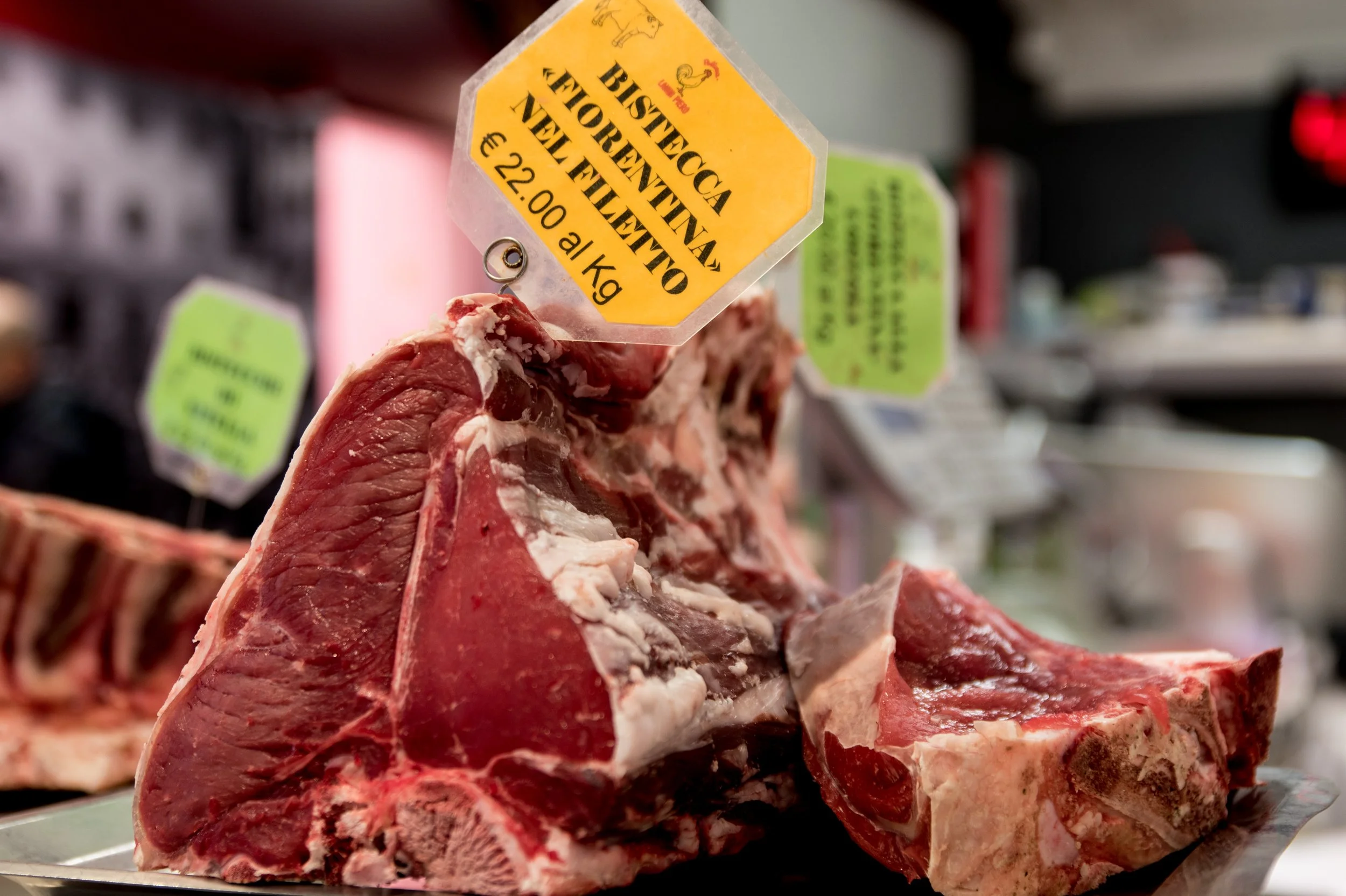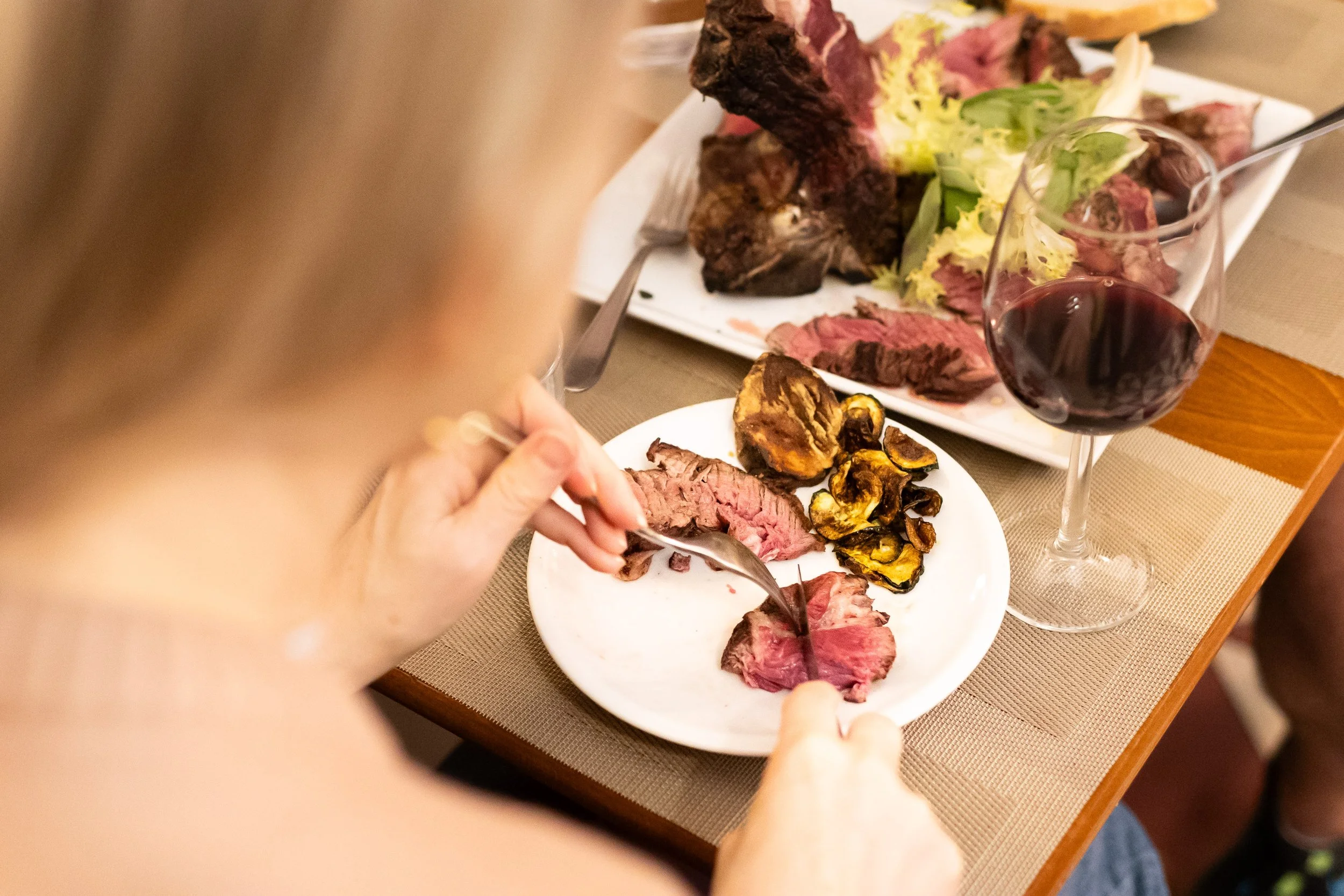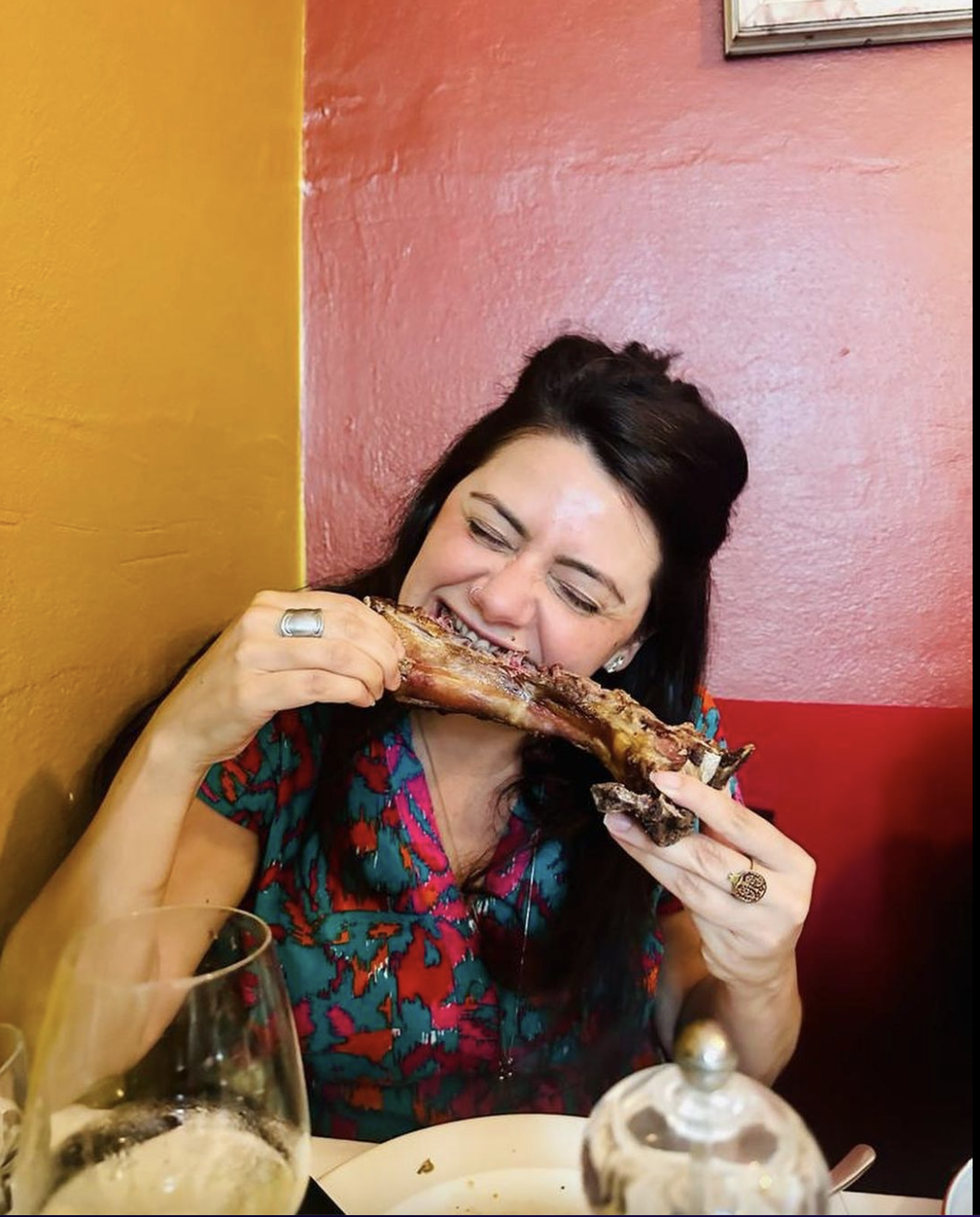The perfect Fiorentina steak must be well browned on the outside and rare inside.
Florence is famous for her steaks or more preciously the Bistecca alla Fiorentina. In the post-pandemic years particularly, this local favorite has exploded onto the international stage thanks to various cameos in mainstream travel media.
Chefs in the spotlight include a 8th generational butcher and uncontested king of Bistecca alla Fiorentina by the name of Dario Cecchini.
If the name rings a bell, you might seen him serving up giant slabs of steak in season six of the Netflix hit series Chef’s Table. And if you’ve seen that, it’s likely you have made a beeline for, or a bucket-list listing for, Cecchini’s Antica Macelleria in the small town of Panzano in the Chianti region, where you can meet the booming chef-turned-butcher and perhaps listen to a few of his famed Dante quotes.
But back in Florence, a Bistecca alla Fiorentina is a dime a dozen. Finding a quality sourced Bistecca alla Fiorentina is a different story. All too often, the dream we have of sampling a prime T-bone Fiorentina from a lovingly reared animal is nothing more than that - a dream. The reality in most tourist hotspots is a tough, stringy lump of neglected meat that is a terrible waste both of cash and animal.
A Fiorentina has a T-bone shape with the fillet on one side and the sirloin on the other. This was taken pre-covid at a butcher stand in Florence- my how pricing times have changed!
So where do you find the best Bistecca alla Fiorentina in Florence?
In this post, we share our preferred spots as well as a little bit of history and background, so you walk into your chosen restaurant prepped and ready to impress your cameriere (waiter).
Don’t forget to subscribe to our newsletter to stay up to date with the latest from Italy plus plenty more insider tips and travel guides: http://eepurl.com/cEl6cf
A Fiorentina is usually served simply with just olive oil, salt and pepper.
History of the Bistecca alla Fiorentina (Florentine Steak)
The word bistecca like a lot of things in Florence is said to trace its roots back to none other than the Medici family – one of Italy’s most prolific banking families and a political powerhouse in Florence for more than two centuries.
In the 16th century, at the height of the family’s power, the Duke of Florence Cosimo I celebrated the wedding of his daughter Isabella by roasting a whole ox in Piazza San Lorenzo. A handful of English knights just so happened to be among the hungry crowd and started shouting, “Beef steak! Beef steak!” and so the word bistecca was thought to have been born. Food legends are always questionable, if you think about the origins of the word “bistecca” it sounds more like 2 sides to a stake (bis + stecca).
While the legend sounds pretty fanciful, although the event did happen, the first painting of a rib-steak is from around this time, so maybe there’s some truth in it? Just make a beeline next time you’re in the Uffizi for the Dispensa by Jacopo Chimenti to see the steak in all its lucid naturalism.
As for the Florentine steak, it’s likely to have originated from Tuscan farms where the old cows or castrated calves were slaughtered. While originally held in high regard, Florence's guild of butchers was banished to the outskirts of the city by another Medici - Grand Duke Ferdinando I.
For centuries, they had enjoyed prime position on Ponte Vecchio, sweeping their scraps into the Arno as they worked. But Ferdinando hated the smell on his daily walk from his home in Palazzo Pitti to the bridge, so he sent the butchers away and replaced them with the goldsmiths we see today.
bistecca and its history in Florence goes back to 1565.
How a Bistecca alla Fiorentina (Florentine Steak) is made
There is a saying in Florence that anything under four fingers is not steak but carpaccio. In reality, the traditional Bistecca alla Fiorentina should be around three stacked fingers in width or between 800g and 1.2kg in weight. The average steak will set you back 50 euros a kilo and up to 80 euros.
Paradoxically young meat is not what you what for your Fiorentina. An adult bovine is preferred, usually a castrated male known as a steer or vitellone. The cut is from the loin, just below the rib cage and above the rump.
Once cut, the steak has the classic T-bone shape and should be aged generally between 15-20 days and up to 45 (compared to the just 48 hours found in your average supermarket steak). This maturation process not only makes the meat more flavorful, but also helps break down the fibers of the meat, making it more tender.
Cooking a Florentine steak is definitely an art. The room temperature meat is most traditionally grilled over an open flame for no more than 3-5 minutes. The temperature of the pan should be piping hot, so the exterior looks almost charred with clear grill lines.
The inside is very rare and just warm. If you’re not a fan of rare meat, the Fiorentina is not for you. A well-done or even medium steak will be as tough as old boots and not enjoyable at all.
Gnawing on the bone is considered quite the treat and is usually reserved for the guest of honor!
What breed of cow is used for a Bistecca alla Fiorentina?
For a PAT certified steak (PAT is the list of traditional Italian food products set up by the Ministry of Agriculture, Food and Forestry Policies in collaboration with the regions), your Fiorentina should come from a Tuscan breed - Chianina, Calvana or Maremmana or a non-Tuscan breed born and bred in Tuscany.
Chianina is the local historic favorite. It’s an ancient breed of cattle and one of the world’s largest, raised in the Val di Chiana about an hour’s drive from Florence. These big and tall cows were originally used as draft animals but are now prized for their lean meat.
For more succulent marbling, you will probably find breeds from elsewhere around Italy. There’s nothing wrong with a steak that isn’t PAT certified or is not Chianina- as long as it was sourced and aged with care and quality intention.
How is the Florentine Steak served?
Traditionally, Florentines pair Bistecca alla Fiorentina with roast potatoes, sautéed spinach or silverbeet, white cannellini beans and Tuscan bread. The meat is so delicious that it does not need a sauce - simply eat it with salt, pepper and a little olive oil.
In Florence, it is now common knowledge that a cut under four fingers it is not a steak but carpaccio.
Where to get excellent Bistecca alla Fiorentina in Florence
Osteria dell’Enoteca (Via Romana, 70): The perfect mix of youthful diners and elegant old style exposed brick dining spaces. The food is modern Tuscan and the Fiorentina is grilled over an open flame, served with salt and fresh rosemary.
All’Antico Ristoro di Cambi (Via Sant'Onofrio, 1): Opened in the ’50s as a simple fiaschetteria (wine shop), the Cambi family started with a small kitchen which served honest food to go along with the straw-covered bottles of Chianti. The Fiorentina here is delicious, well-priced and served without bells and whistles, which is a good thing.
I'Tuscani (Piazza di S. Pancrazio, 2): A self-declared steakhouse, I’Tuscani has two spots in the city. The S.Pancrazio address is the O.G. I particularly like this steakhouse for the different breeds on offer with Pisana, Maremmana and Chianina all on the menu, as well as some very creative starters including fried lampredotto meatballs with salsa verde.
Terrazza Menoni (inside the Mercato di Sant’Ambrogio): Florence’s original butcher/restaurant, this local favorite has been kicking around since the 1920s. Unlike a lot of other steak spots, butcher Luca Menoni prefers non-native breeds such as Limousin, Romagnola or Charolais born and bred in Tuscany and grilled over a fire of Tuscan olive branches rather than coal.
Trattoria dall’Oste (Via degli Orti Orticellari, 29): There are a few Trattoria dall’Oste around in Florence, so make sure you make a beeline for this address. It’s quite the prize winner, making it into the top 50 World Best Steak Restaurants in 2024. Aside from its amazing steaks, the Ribollita Toscana vegetable soup is also very good, if you have the room.
Regina Bistecca (Via Ricasoli, 14): Great steak in an elegant, retro setting. Get a table towards the back and you may be able to see the grill at work, flames gusting upwards just beyond the kitchen’s glass wall. The breeds of Fiorentina are varied and variably priced, so there’s something for everyone.
Our Progressive Tuscan Dining Crawl of Florence! Let us take the mystery and stress out of ordering a Florentine steak while mitigating food waste as the steak is shared in this unique group tour (as its meant to be)– we take you to one of the city’s best spots, serving carefully aged cuts and ensure its cooked to perfection. We also share a rundown on the cuts used in today’s restaurants along with wine pairing hacks.
Spoiler alert: It’s not perennial Tuscan red, the Brunello, and on the tour you’ll taste why.












